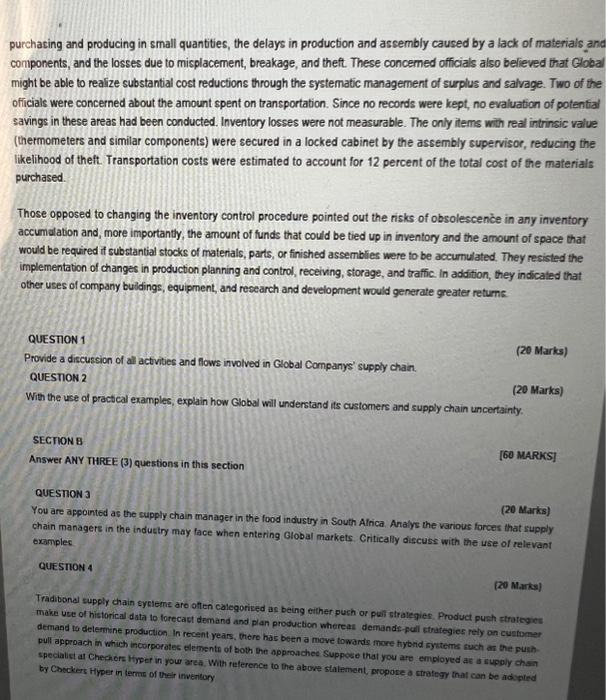purchasing and producing in small quantities, the delays in production and assembly caused by a lack of materials and components, and the losses due

purchasing and producing in small quantities, the delays in production and assembly caused by a lack of materials and components, and the losses due to misplacement, breakage, and theft. These concerned officials also believed that Global might be able to realize substantial cost reductions through the systematic management of surplus and salvage. Two of the officials were concerned about the amount spent on transportation. Since no records were kept, no evaluation of potential savings in these areas had been conducted. Inventory losses were not measurable. The only items with real intrinsic value (thermometers and similar components) were secured in a locked cabinet by the assembly supervisor, reducing the likelihood of theft. Transportation costs were estimated to account for 12 percent of the total cost of the materials purchased. Those opposed to changing the inventory control procedure pointed out the risks of obsolescence in any inventory accumulation and, more importantly, the amount of funds that could be tied up in inventory and the amount of space that would be required if substantial stocks of materials, parts, or finished assemblies were to be accumulated. They resisted the implementation of changes in production planning and control, receiving, storage, and traffic. In addition, they indicated that other uses of company buildings, equipment, and research and development would generate greater returns. QUESTION 1 Provide a discussion of all activities and flows involved in Global Companys' supply chain. QUESTION 2 (20 Marks) With the use of practical examples, explain how Global will understand its customers and supply chain uncertainty. SECTION B Answer ANY THREE (3) questions in this section (20 Marks) QUESTION 4 [60 MARKS] QUESTION 3 (20 Marks) You are appointed as the supply chain manager in the food industry in South Africa. Analys the various forces that supply chain managers in the industry may face when entering Global markets. Critically discuss with the use of relevant examples (20 Marks) Traditional supply chain systems are often categorised as being either puch or pull strategies. Product push strategies make use of historical data to forecast demand and plan production whereas demands-pull strategies rely on customer demand to determine production. In recent years, there has been a move towards more hybnd systems such as the push- pull approach in which incorporates elements of both the approaches Suppose that you are employed as a supply chain specialist at Checkers Hyper in your area. With reference to the above statement, propose a strategy that can be adopted by Checkers Hyper in terms of their inventory
Step by Step Solution
There are 3 Steps involved in it
Step: 1
The image youve shared contains text which outlines a case study or scenario related to inventory management and supply chain within a company referred to as Global Company The content mentions variou...
See step-by-step solutions with expert insights and AI powered tools for academic success
Step: 2

Step: 3

Ace Your Homework with AI
Get the answers you need in no time with our AI-driven, step-by-step assistance
Get Started


